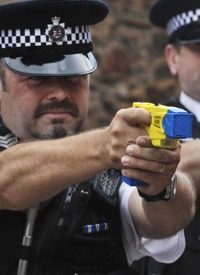
The Ninth U.S. Circuit Court of Appeals in San Francisco ruled on December 28 that police officers need sufficient reason to believe a suspect is dangerous before shooting them with a Taser, the San Francisco Chronicle reported on December 29.
The ruling sets judicial standards for police to follow, standards that people who are Tasered may refer to when claiming they were victims of excessive force. When a suspect simply disobeys orders or acts erratically without posing an obvious danger, Taser use is not justified.
"The objective facts must indicate that the suspect poses an immediate threat to the officer or a member of the public," Judge Kim Wardlaw declared in the unanimous ruling by the three-member court.
While indicating that Tasers are a valuable, nonlethal alternative to firearms in dangerous situations, Wardlaw noted that the stun guns cause a "painful and frightening blow" to the suspect. Taser use must therefore be restricted to situations where this level of substantial force is justified and there are no other options available.
The ruling was prompted by the case of Carl Bryan, a San Diego-area man who was Tasered by a police officer named Brian McPherson. Officer McPherson had stopped Bryan for not wearing his seat belt, and he eventually Tasered Bryan after Bryan had gotten out of his vehicle.
"It’s a significant use of force, not like cuffing someone or using pain compliance or pepper spray," said Eugene Iredale, a lawyer for Bryan. "It’s not to be used promiscuously or lightly."
The appeals court ruling will allow Bryan to bring to trial his damage suit against McPherson. McPherson’s lawyers were not available to offer any comment on the ruling.
McPherson stopped Bryan while Bryan was driving home on a summer morning in 2005. Bryan was wearing only shorts and tennis shoes, and he was angry with himself for forgetting to fasten his seat belt. According to the court, he swore at himself as he got out of his car, and he was shouting gibberish and banging his thighs while standing 15 to 25 feet away from McPherson.
McPherson said Bryan then stepped toward him, though Bryan denied this, and the officer fired his Taser. The court stated that the evidence showed Bryan was facing away from McPherson when the Taser darts struck him.
Bryan fell on his face, breaking four front teeth. He also required a hospital visit to remove the Taser dart. Bryan was charged with misdemeanors of resisting and opposing an officer, though prosecutors dropped the charges after the initial jury deadlocked.
The appeals court upheld a judge’s refusal to dismiss Bryan’s civil suit against McPherson, saying a jury should decide if the police officer used excessive force on someone who was not a threat. There are factors in favor of Bryan winning damages from McPherson.
Judge Wardlaw noted that Bryan was clearly unarmed and did not challenge McPherson verbally or make any threatening gestures. She said McPherson’s claim that Bryan disobeyed an order to stay in his vehicle, something Bryan denied hearing, does not in itself justify shooting Bryan with a Taser. Even McPherson’s concern that Bryan might be mentally disturbed would not alone warrant Taser use.
Additionally, Wardlaw said there were other points supporting a claim of excessive force: the minor nature of the traffic offense, McPherson’s failure to warn Bryan before firing the Taser, and the fact that backup officers were on their way to the scene.
Tasers are certainly valuable tool for law enforcement officers, enabling them to use nonlethal force in certain situations where otherwise they would have no choice but to use lethal force. But like any tool, they must be used with discretion and restraint so that the power they offer is not abused.
Photo: AP Images



